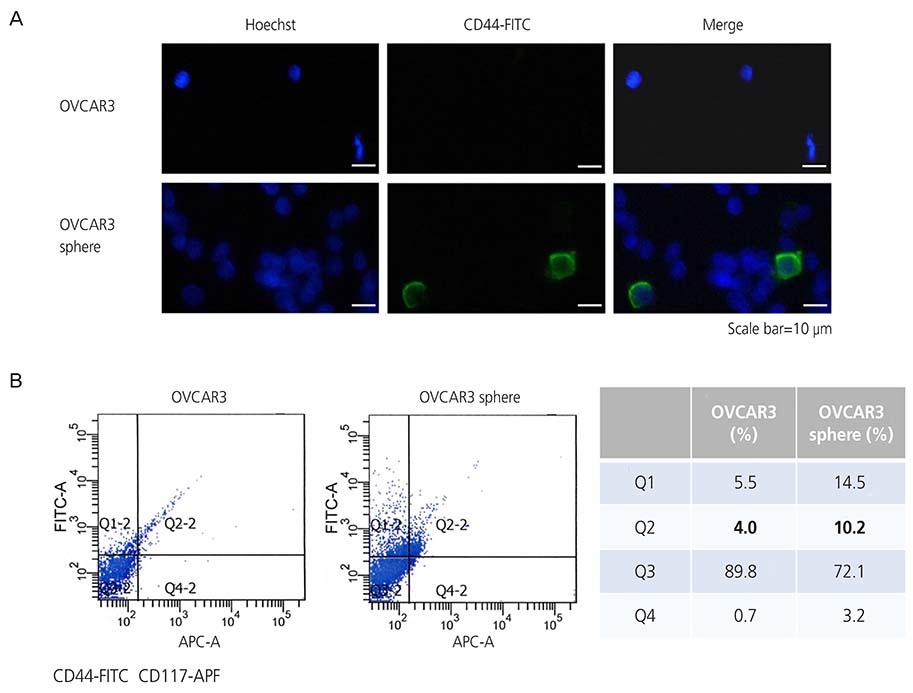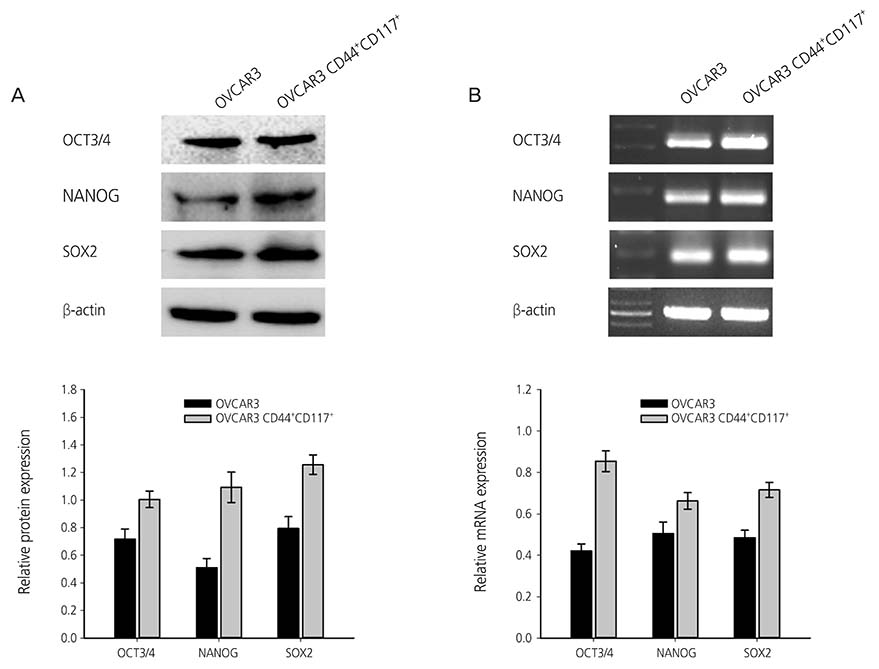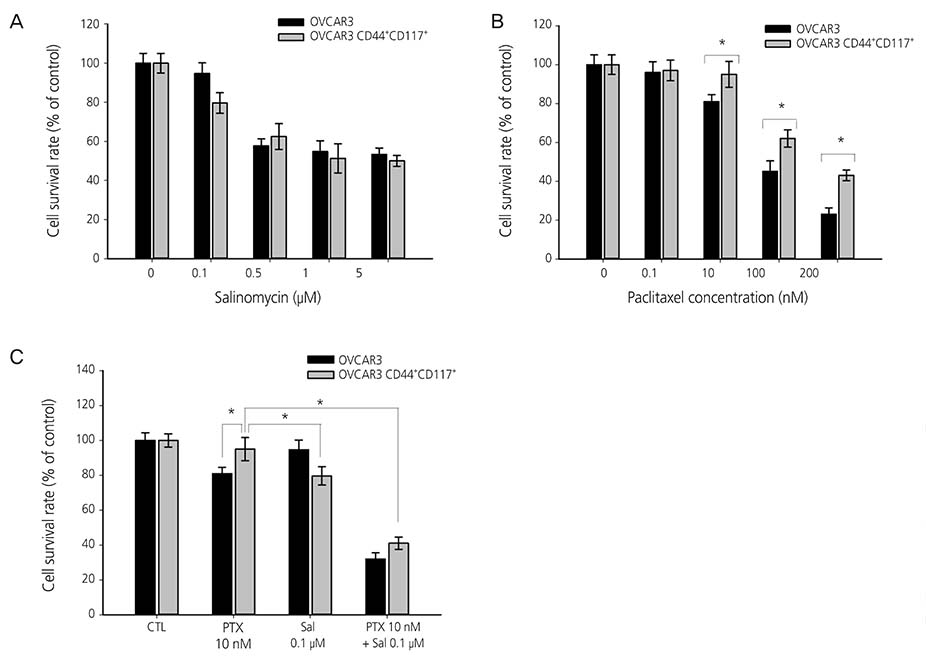Obstet Gynecol Sci.
2016 Jul;59(4):261-268. 10.5468/ogs.2016.59.4.261.
The effect of salinomycin on ovarian cancer stem-like cells
- Affiliations
-
- 1Department of Obstetrics and Gynecology, Keimyung University School of Medicine, Daegu, Korea. chcho@kmu.ac.kr
- KMID: 2329046
- DOI: http://doi.org/10.5468/ogs.2016.59.4.261
Abstract
OBJECTIVE
The identification of cancer stem-like cells is a recent development in ovarian cancer. Compared to other cancer cells, cancer stem-like cells present more chemo-resistance and more aggressive characteristics. They play an important role in the recurrence and drug resistance of cancer. Therefore, the target therapy of cancer stem-like cell may become a promising and effective approach for ovarian cancer treatment. It may also help to provide novel diagnostic and therapeutic strategies.
METHODS
The OVCAR3 cell line was cultured under serum-free conditions to produce floating spheres. The CD44âºCD117⺠cell line was isolated from the human ovarian cancer cell line OVCAR3 by using immune magnetic-activated cell sorting system. The expression of stemness genes such as OCT3/4, NANOG and SOX2 mRNA were determined by reverse transcription polymerase chain reaction. OVCAR3 parental and OVCAR3 CD44âºCD117⺠cells were grown in different doses of paclitaxel and salinomycin to evaluate the effect of salinomycin. And growth inhibition of OVCAR3 CD44+CD117+ cells by paclitaxel combined with salinomycin was determined by the 3-(4,5-dimethylthiazol-2-yl)-2,5-diphenyl-2H-tetrazolium bromide (MTT) assay.
RESULTS
Tumor spheroids generated from the OVCAR3 cell line are shown to have highly enriched CD44 and CD117 expression. Treatment with a combination of paclitaxel and salinomycin demonstrated growth inhibition of OVCAR3 CD44+CD117+ cells.
CONCLUSION
The present study is a detailed investigation on the expression of CD44 and CD117 in cancer stem cells and evaluates their specific tumorigenic characteristics in ovarian cancer. This study also demonstrates significant growth inhibition of cancer stem-like cells by paclitaxel combined with salinomycin. Identification of these cancer stem-like cell markers and growth inhibition effect of salinomycin may be the next step to the development of novel target therapy in ovarian cancer.
Keyword
MeSH Terms
Figure
Reference
-
1. Ozols RF. Treatment goals in ovarian cancer. Int J Gynecol Cancer. 2005; 15:Suppl 1. 3–11.2. Banerjee S, Kaye SB. New strategies in the treatment of ovarian cancer: current clinical perspectives and future potential. Clin Cancer Res. 2013; 19:961–968.3. Foster R, Buckanovich RJ, Rueda BR. Ovarian cancer stem cells: working towards the root of stemness. Cancer Lett. 2013; 338:147–157.4. Ahmed N, Abubaker K, Findlay J, Quinn M. Cancerous ovarian stem cells: obscure targets for therapy but relevant to chemoresistance. J Cell Biochem. 2013; 114:21–34.5. Zhan Q, Wang C, Ngai S. Ovarian cancer stem cells: a new target for cancer therapy. Biomed Res Int. 2013; 2013:916819.6. Loh YH, Wu Q, Chew JL, Vega VB, Zhang W, Chen X, et al. The Oct4 and Nanog transcription network regulates pluripotency in mouse embryonic stem cells. Nat Genet. 2006; 38:431–440.7. Mitani M, Yamanishi T, Miyazaki Y. Salinomycin: a new monovalent cation ionophore. Biochem Biophys Res Commun. 1975; 66:1231–1236.8. Gupta PB, Onder TT, Jiang G, Tao K, Kuperwasser C, Weinberg RA, et al. Identification of selective inhibitors of cancer stem cells by high-throughput screening. Cell. 2009; 138:645–659.9. Resham K, Patel PN, Thummuri D, Guntuku L, Shah V, Bambal RB, et al. Preclinical drug metabolism and pharmacokinetics of salinomycin, a potential candidate for targeting human cancer stem cells. Chem Biol Interact. 2015; 240:146–152.10. Chen J, Wang J, Chen D, Yang J, Yang C, Zhang Y, et al. Evaluation of characteristics of CD44+CD117+ ovarian cancer stem cells in three dimensional basement membrane extract scaffold versus two dimensional monocultures. BMC Cell Biol. 2013; 14:7.11. Jayson GC, Kohn EC, Kitchener HC, Ledermann JA. Ovarian cancer. Lancet. 2014; 384:1376–1388.12. Hermann PC, Huber SL, Heeschen C. Metastatic cancer stem cells: a new target for anti-cancer therapy? Cell Cycle. 2008; 7:188–193.13. Dean M, Fojo T, Bates S. Tumour stem cells and drug resistance. Nat Rev Cancer. 2005; 5:275–284.14. Clarke MF, Dick JE, Dirks PB, Eaves CJ, Jamieson CH, Jones DL, et al. Cancer stem cells: perspectives on current status and future directions: AACR Workshop on cancer stem cells. Cancer Res. 2006; 66:9339–9344.15. Shi MF, Jiao J, Lu WG, Ye F, Ma D, Dong QG, et al. Identification of cancer stem cell-like cells from human epithelial ovarian carcinoma cell line. Cell Mol Life Sci. 2010; 67:3915–3925.16. Zhang S, Balch C, Chan MW, Lai HC, Matei D, Schilder JM, et al. Identification and characterization of ovarian cancer-initiating cells from primary human tumors. Cancer Res. 2008; 68:4311–4320.17. Bapat SA, Mali AM, Koppikar CB, Kurrey NK. Stem and progenitor-like cells contribute to the aggressive behavior of human epithelial ovarian cancer. Cancer Res. 2005; 65:3025–3029.18. Burgos-Ojeda D, Rueda BR, Buckanovich RJ. Ovarian cancer stem cell markers: prognostic and therapeutic implications. Cancer Lett. 2012; 322:1–7.19. Alvero AB, Chen R, Fu HH, Montagna M, Schwartz PE, Rutherford T, et al. Molecular phenotyping of human ovarian cancer stem cells unravels the mechanisms for repair and chemoresistance. Cell Cycle. 2009; 8:158–166.20. Luo L, Zeng J, Liang B, Zhao Z, Sun L, Cao D, et al. Ovarian cancer cells with the CD117 phenotype are highly tumorigenic and are related to chemotherapy outcome. Exp Mol Pathol. 2011; 91:596–602.21. Naujokat C, Steinhart R. Salinomycin as a drug for targeting human cancer stem cells. J Biomed Biotechnol. 2012; 2012:950658.22. Miyazaki Y, Shibuya M, Sugawara H, Kawaguchi O, Hirsoe C. Salinomycin, a new polyether antibiotic. J Antibiot (Tokyo). 1974; 27:814–821.23. An H, Kim JY, Lee N, Cho Y, Oh E, Seo JH. Salinomycin possesses anti-tumor activity and inhibits breast cancer stem-like cells via an apoptosis-independent pathway. Biochem Biophys Res Commun. 2015; 466:696–703.24. Qu H, Ma B, Yuan HF, Wang ZY, Guo SJ, Zhang J. Effect of salinomycin on metastasis and invasion of bladder cancer cell line T24. Asian Pac J Trop Med. 2015; 8:578–582.
- Full Text Links
- Actions
-
Cited
- CITED
-
- Close
- Share
- Similar articles
-
- Salinomycin reduces stemness and induces apoptosis on human ovarian cancer stem cell
- Salinomycin inhibited cell proliferation and induced apoptosis in human uterine leiomyoma cells
- Chemoresistance in ovarian cancer: exploiting cancer stem cell metabolism
- Cancer Stem Cells in Brain Tumors and Their Lineage Hierarchy
- SURF4 maintains stem-like properties via BIRC3 in ovarian cancer cells




